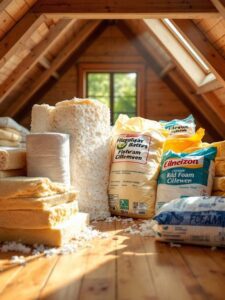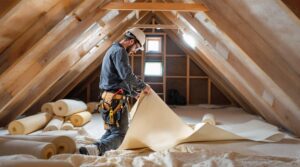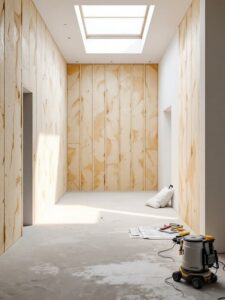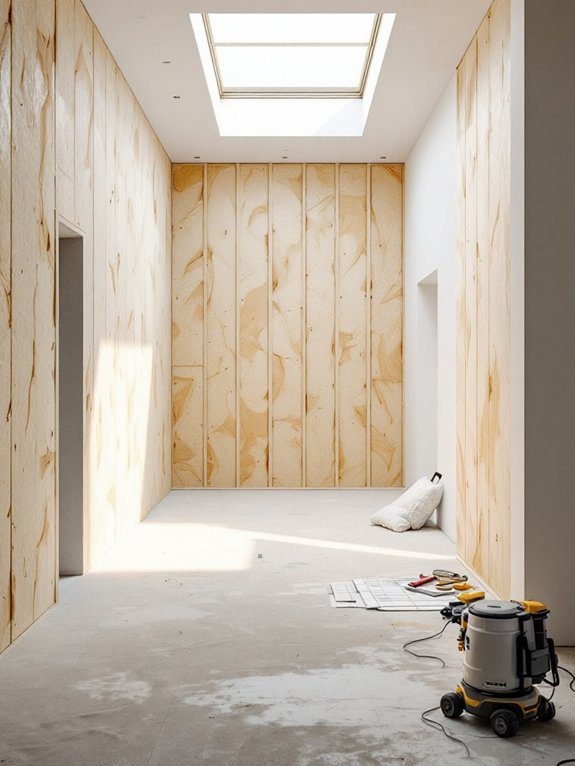External wall insulation offers multiple aesthetic enhancement options to transform your home’s exterior while improving energy efficiency. You’ll find finishes ranging from smooth acrylics for modern looks to textured minerals for traditional styles. Color choices can optimize thermal performance – light shades reflect heat, while darker tones absorb it. Decorative elements like moldings, reveals, and feature bands add architectural interest without compromising insulation. The possibilities extend beyond basic thermal upgrades into complete exterior transformation.
Key Takeaways
- External wall insulation offers diverse finish options from traditional textured renders to modern smooth surfaces, enhancing architectural aesthetics.
- Decorative elements like moldings, cornices, and feature bands can be integrated while maintaining insulation performance.
- Color selection impacts both visual appeal and energy efficiency, with light colors reflecting heat and dark shades absorbing it.
- Different textures create visual interest through shadow lines and patterns while providing protection against weather elements.
- Installation transforms dated facades into fresh, modern appearances while improving energy efficiency and interior comfort.
Choosing the Right Finish for Your Property’s Style

When selecting an external wall insulation finish, you’ll need to carefully consider how it complements your property’s architectural style and character.
Different finish materials can dramatically impact your home’s visual appeal and its integration with the surrounding neighborhood.
For traditional properties, textured mineral renders or brick-effect finishes maintain historical authenticity while providing modern insulation benefits.
Contemporary property styles often benefit from smooth acrylic renders or metallic finishes that create clean, striking facades.
You’ll find that silicon-based renders offer excellent durability and weather resistance across all architectural types, making them a versatile choice for long-term sustainability.
Consider how your chosen finish will age and weather in your local climate, ensuring it’ll maintain its appearance and performance throughout its lifecycle.
The right finish harmoniously blends aesthetics with practical performance.
Color Selection and Visual Impact
Beyond the textural elements of your external wall insulation, color selection stands as a defining factor in your property’s visual presentation.
When choosing colors, you’ll need to take into account both color psychology and your neighborhood’s existing palette to create visual harmony with surrounding properties.
Light colors reflect more sunlight, reducing cooling costs in warmer climates, while darker shades can help absorb heat in colder regions.
You’ll find that neutral tones often provide timeless appeal and better resale value, while bold colors can make your property a distinctive landmark.
Reflect on how your color choice will interact with natural light throughout the day and complement existing architectural features.
Remember that your selection isn’t just about aesthetics—it’s about creating a sustainable, energy-efficient home that resonates with your community’s character.
Texture Options and Architectural Effects

Selecting the right texture for external wall insulation creates significant architectural impact while enhancing your home’s weather resistance.
You’ll find various texture types that can complement your architectural style, from smooth renders to deeply textured finishes. You can choose from pebbledash effects that provide robust protection against weathering, or opt for contemporary smooth finishes that create a sleek, modern appearance.
Traditional architectural styles benefit from roughcast textures that replicate historic rendering techniques, while modern homes often suit clean, minimalist surfaces.
You’ll discover that ribbed or grooved patterns can add visual interest and help disguise joint lines between insulation panels.
When you’re planning your exterior renovation, consider how different textures can enhance shadow lines, create depth, and integrate seamlessly with existing architectural features.
Design Elements and Decorative Features
While external wall insulation provides essential thermal benefits, it also offers numerous opportunities to incorporate decorative elements that enhance your building’s aesthetic appeal.
You’ll find that modern insulation systems allow for seamless integration of decorative accents while maintaining architectural harmony with surrounding structures.
- You can incorporate custom moldings and cornices that complement your building’s period features, creating visual interest at rooflines and window surrounds.
- Add dimensional patterns and reveals to break up large wall surfaces, creating depth and shadow effects that enhance your façade’s character.
- Install feature bands and string courses between floor levels to establish horizontal emphasis and maintain proportion.
These design elements won’t compromise your insulation’s performance, ensuring you achieve both energy efficiency and visual appeal in your renovation project.
Before and After: Transforming Your Home’s Exterior

The installation of external wall insulation can dramatically transform a property’s appearance, taking it from dated and energy-inefficient to modern and thermally optimized. You’ll notice immediate improvements in both curb appeal and energy efficiency as your home undergoes this transformation.
| Before Installation | After Installation |
|---|---|
| Weathered façade | Fresh, modern finish |
| High energy bills | Reduced heating costs |
| Cold interior walls | Comfortable surfaces |
| Dated appearance | Enhanced curb appeal |
When you opt for external wall insulation, you’re not just upgrading your home’s thermal performance – you’re investing in its visual appeal. The process allows you to select from contemporary finishes, textures, and colors that’ll complement your neighborhood while maintaining your property’s unique character. Your home’s transformation will stand as a demonstration of sustainable living and smart renovation choices.
Frequently Asked Questions
How Long Does External Wall Insulation Typically Last Before Needing Replacement?
You’ll typically get 25-30 years from properly installed external wall insulation. Watch for lifespan factors like weather exposure and maintenance. Check for replacement signs including cracks, dampness, or detachment from walls.
Can External Wall Insulation Be Installed During Winter Months?
Sure, you can brave the winter blues for installation, but you’ll need dry conditions and temperatures above 5°C. Weather considerations like rain and frost will impact adhesives, so careful planning is essential for successful winter installation.
Will External Wall Insulation Affect My Property’s Resale Value?
You’ll likely see a boost in resale value since external wall insulation improves your home’s energy efficiency and property appeal. Buyers increasingly value sustainable features that reduce energy costs and enhance comfort.
Do I Need Planning Permission to Install External Wall Insulation?
Like wrapping your home in a protective blanket, you’ll typically need planning permission for external wall insulation. However, many areas offer installation guidelines and planning exemptions if you’re following standard specifications and height restrictions.
How Much Maintenance Does External Wall Insulation Require Annually?
You’ll need minimal maintenance with annual visual inspections for cracks or damage. Follow these maintenance tips: check seals around windows, clean surfaces gently, and address any issues promptly to guarantee your insulation’s long-term performance.
Conclusion
External wall insulation isn’t just about thermal efficiency – it’s your chance to transform your home’s entire aesthetic identity. As they say, “Don’t judge a book by its cover,” but your property’s exterior speaks volumes about its character. You’ll maximize both energy performance and visual appeal by carefully selecting finishes, colors, and textures that complement your architectural style while ensuring sustainable, long-lasting results.









12 Responses
h4gtxb
F*ckin’ amazing things here. I am very happy to look your post. Thank you a lot and i’m looking ahead to touch you. Will you please drop me a mail?
Greetings from Carolina! I’m bored to tears at work so I decided to browse your blog on my iphone during lunch break. I enjoy the knowledge you provide here and can’t wait to take a look when I get home. I’m shocked at how quick your blog loaded on my phone .. I’m not even using WIFI, just 3G .. Anyhow, good blog!
you are truly a just right webmaster. The web site loading pace is amazing. It seems that you’re doing any distinctive trick. In addition, The contents are masterpiece. you have done a great task in this matter!
Hey! I just wish to give a huge thumbs up for the good info you may have here on this post. I can be coming back to your weblog for extra soon.
I discovered your blog site on google and check a few of your early posts. Continue to keep up the very good operate. I just additional up your RSS feed to my MSN News Reader. Seeking forward to reading more from you later on!…
As soon as I observed this internet site I went on reddit to share some of the love with them.
Thanks for sharing. I read many of your blog posts, cool, your blog is very good. https://accounts.binance.com/register-person?ref=IHJUI7TF
I definitely wanted to send a word in order to appreciate you for some of the nice hints you are sharing on this website. My extensive internet investigation has finally been honored with really good ideas to write about with my family. I ‘d tell you that many of us site visitors actually are truly endowed to be in a very good place with very many marvellous professionals with beneficial principles. I feel somewhat grateful to have used your webpage and look forward to tons of more thrilling minutes reading here. Thanks a lot again for everything.
Thanks for sharing. I read many of your blog posts, cool, your blog is very good.
Excellent blog right here! Additionally your site quite a bit up very fast! What host are you the usage of? Can I get your associate link to your host? I wish my website loaded up as fast as yours lol
Can you be more specific about the content of your article? After reading it, I still have some doubts. Hope you can help me.